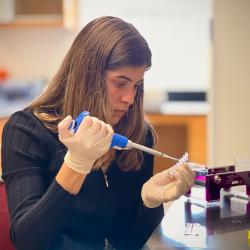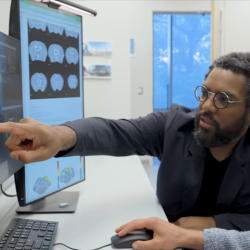MedStar Washington Hospital Center's Jeffrey Shupp (B.S. '01, Biological Sciences) Helps Save Burn Patient
Shupp is director of the Burn Center at MedStar Washington
Jeff Davis started his 40-year career working on merchant ships all over the world. He worked up to tugboat captain, safely steering barges as big as football fields through the treacherous waters along every U.S. coast. But it was an ordinary motorcycle ride on a summer day in southern Maryland that proved the most dangerous voyage of his life.
When his cycle collided with a larger vehicle, gas spilled and flames erupted. Within seconds, Capt. Davis’s body was ablaze. Passersby helped smother the fire, and a state police helicopter loaded Capt. Davis aboard for the trip to MedStar Washington Hospital Center—and its renowned Burn Center, where he would stay 17 months.
The Burn Center, the only adult burn treatment facility in the Washington area, serves the District, southern Maryland, northern Virginia and eastern West Virginia. Every year, more than 1,000 patients are treated at the center by a multidisciplinary team of experts including surgeons, nurses, nutritionists, pharmacists, rehabilitation therapists, and many other allied health professionals.
The Threat of Poly-Trauma
When Capt. Davis arrived at the hospital he was in critical condition. “He had multiple traumatic injuries including broken bones and very deep burns covering more than 50 percent of his body,” explains Jeffrey Shupp, MD, Burn Center director. Working collaboratively, the Trauma, Interventional Radiology and Orthopedic Surgery teams gathered to manage his complex care.
Among his serious fractures was a broken pelvis—an injury that can lead to difficult-to-control bleeding. So Capt. Davis was first rushed to Interventional Radiology for a procedure to block bleeding vessels.
Once this threat was thwarted, the Burn team turned to tackle the third and fourth degree burns that covered his body from his waist down. The damage was so severe it reached into the underlying bones, muscles, tendons, and nerve endings.
“With a burn of this degree, burn shock can be lethal,” Dr. Shupp says. “Capt. Davis required more than 20 liters of fluid to support his cardiovascular system during the first 24 hours in the hospital. Once we get a large burn through this initial resuscitation, we need to begin debridement to remove burned tissue to stop inflammation and control infection.”
Lost in Dreams
Capt. Davis has no memory of those early days—nor the months of intensive care that followed. But he has read his wife Bonnie’s journal—a daily, heartwrenching account. That’s where he learned about his round-the-clock care and dozens of surgeries, including a sudden wrinkle in her husband’s recovery. Weeks into his hospitalization, Capt. Davis developed internal bleeding from an unknown source.
“It was a mystery we needed to solve quickly,” says Dr. Shupp. “We were able to identify the bleed was in his colon where he previously had surgery. Dr. Laura Johnson and I had to remove much of his large bowel to stop the bleeding.” It was a setback—but Capt. Davis continued to defy the odds.
“It’s strange,” Capt. Davis says now. “I think I had this recurring dream. I felt as if I was in a shallow pool with other people floating, and we were in pain, but knew we just had to do our time and would eventually regain strength.”
The Benefit of Research
Three months into his hospitalization, it was time to graft new skin tissue on his wounds, using cadaver tissue and an innovative new tool available in just a few hospitals nationwide.
“We have been involved in clinical trials testing a medical device called ReCell® and received a compassionate waiver for Capt. Davis,” Dr. Shupp explains. “ReCell uses a very small sample of the patient’s skin to reconstitute cells into a spray. It’s an important additional grafting technique for patients like Capt. Davis who don’t have enough healthy skin for standard grafting.”
When his wounds were adequately healed, Capt. Davis began rehabilitation. Months of sedentary hospitalization, stiffening of muscle and loss of nerve sensation made movement difficult. And his 6’ 1” frame had withered to 120 lbs.
“When I first left the ICU, just getting into my wheelchair was a big feat,” he says. “But the therapists took good care of me and helped get me stronger. Everyone at the hospital was wonderful, and I know it’s a miracle I’m alive. They are great people who became my friends.”
“Capt. Davis’s recovery is a testament to the multidisciplinary team taking care of him,” says Dr. Johnson. “Everyone collaborated with his recovery. He and his wife are minor celebrities every time they come for a visit.”
Homecoming
On December 3, 2016, more than 17 months after he first arrived, Capt. Davis was discharged. “A van picked me up and took me home to St. Mary’s,” he says. “My wife, a couple of friends, and my dog Choco were waiting for me. When I left, Choco was just a puppy, but he remembered me!”
Not one to sit around, Capt. Davis was soon riding a customized bike and this fall, started driving again, using a custom-made car with hand controls. His years captaining tugboats paid off. He says, “I was supposed to have six to eight training sessions before getting my license, but the therapist spent one session with me and approved my license.”
With home nursing and physical therapy, and “Bonnie’s remarkable strength, things are getting better,” he adds. “My wife and I went to Florida for a month and are planning to go back.”
Mrs. Davis grew up in a large family of watermen in St. Mary’s County, and most live within a few miles of each other in Piney Point. She has devoted most of her time to her husband’s recovery, but family members have offered tremendous support and enjoy regular family get-togethers with Maryland seafood at their home on the water.
“I know this wasn’t the retirement we dreamed of," Capt. Davis says, "and I don’t have great expectations. I just want to be strong enough to leave my wheelchair behind and walk with a walker into a restaurant or a friend’s home. Thanks to so many people, I may just get there.”
###
This article originally appeared in Center Scope, a publication produced by the Public Affairs & Marketing Department of MedStar Washington Hospital Center.
Thumbnail photo by G.dallorto (CC-BY-SA-2.5)
UMD Media Relations Contact: Irene Ying, 301-405-5204, zying@umd.edu
University of Maryland
College of Computer, Mathematical, and Natural Sciences
2300 Symons Hall
College Park, MD 20742
www.cmns.umd.edu
@UMDscience
About the College of Computer, Mathematical, and Natural Sciences
The College of Computer, Mathematical, and Natural Sciences at the University of Maryland educates more than 9,000 future scientific leaders in its undergraduate and graduate programs each year. The college’s 10 departments and more than a dozen interdisciplinary research centers foster scientific discovery with annual sponsored research funding exceeding $175 million.







